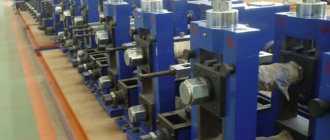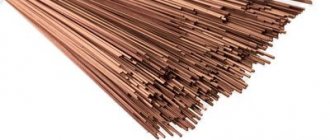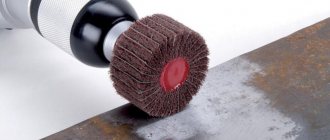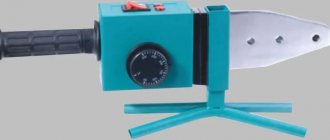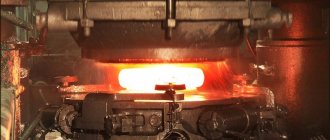Pipe rolling is a necessary part of the process of partially changing the shape of pipes, due to which hollow metal products are given the required configuration or the diameter is expanded. Pipes can be rolled in different directions, depending on the intended result. The process of changing the diameter is carried out on machines in the workshop or at home - using simple devices. Using the rolling method, it is also possible to form products from sheet metal.
To change the original shape of the pipe, a rolling operation is used
Features of the rolling process
Rolling is an affordable process for manufacturing all kinds of metal parts or pipe sections of the required format. Each tube flaring tool has its own specifics, but this process is also used for other purposes - processing a metal rod or thin sheet metal.
The name of the process comes from a primitive device - special rollers are quite simple in design and operation, but they provide a wide rounding radius for the workpieces. Industrial production involves the use of forging rollers (rolls) through which a piece of metal passes.
Correct use of the tool guarantees high-quality and uniform deformation along a given circle or at a certain angle. For example, you can get a blank of the correct cylindrical shape or a curl for a forged gate using rollers for a profile pipe with your own hands.
Rollers are selected according to the thickness of the metal product; rollers with a large radius are often required. Not only steel becomes ductile when processed with the above devices. Plastics, polymeric materials and some rods, sheets and metals are deformed in a similar way:
- aluminum;
- black metal;
- soft alloys;
- galvanization.
Rolling is also called rolling a pipe on a special machine in order to obtain a bent workpiece
Attention! Today, pipe bending and rolling is a common service, but you can master this process yourself if you have an easy-to-use device. Such skills are applicable in various folk fields and industrial production, in the manufacture of welded structures - stairs, gates, furniture.
The most common methods of forming metal products after rolling a profile pipe:
- stretching;
- bending;
- winding;
- flaring of holes.
The process involves securing the pipe into the lumen using expansion, and the diameter of the pipe must be smaller than the opening. To ensure reliable connection, rolling equipment is used. But this concept implies different processes:
- Rolling as a method of changing the width of the inlet hole, lumen or diameter of the pipe during heat treatment and welding.
- Rolling of pipe bends.
- Rolling as a method of reducing diameter.
- Rolling a section of seamless pipeline.
- Flaring the workpiece to change the diameter of the pipe (increase).
Attention! Without experience, pipe rolling is not an easy task, and with excessive force, the metal will lose its ductility and may crack, and other signs of destruction will appear.
This is interesting: Chrome plating - decorative coating of metal with chromium: technology, types
Rolling and bending
Metal rolling
In the procurement area of the plant there is a rolling machine purchased for the manufacture of drying drums and other agricultural machines. Additionally, we provide rolling services for sheet metal with a thickness of 0.8 to 16 mm (for steel grade ST3).
It is possible to roll any rolled metal – pipes, channels, angles, rolled sheets, including flanged sheets. The relative position of the rollers determines the bending radius and the shape of the workpiece. The technology makes it possible to produce shells with a diameter from 300 to 3500 mm.
offers custom-made rolling and bending of sheet metal of any complexity. The workshops are equipped with the latest CNC machines - technological equipment for the production of agricultural equipment.
The high performance of the devices allows you to use their potential to provide metalworking services.
Thanks to the updated main production facilities, the plant offers affordable prices for sheet metal rolling and bending services in Nizhny Novgorod. The cost is affected by the complexity of the parts and the number of bends.
Metal processing time is two days.
To order the services of a bending machine or metal rolling, leave your details on the website. Our manager will call you back at a convenient time.
Cost of services
| Sheet thickness | D=500 rub. VAT included | D=1000 rub. VAT included | D=1500 rub. with ND | D=2000 rub. VAT included | D=2500 rub. VAT included | D=3000 rub. VAT included |
| 4 mm | 3 325,00 | 5 500,00 | 8 200,00 | 10 450,00 | 13 437,50 | 15 850,00 |
| 5 mm | 3 914,00 | 6 640,00 | 10 024,00 | 13 844,00 | 15 274,00 | 20 612,00 |
| 6 mm | 3 903,00 | 8 780,00 | 12 816,00 | 15 238,00 | 19 110,50 | 24 308,00 |
| 8 mm | 6 650,00 | 11 000,00 | 16 432,00 | 30 900,00 | 25 844,50 | 33 766,00 |
| 10 mm | 6 828,00 | 12 280,00 | 20 048,00 | 25 688,00 | 30 548,00 | 39 224,00 |
| 12 mm | 8 006,00 | 13 560,00 | 21 664,00 | 28 476,00 | 34 251,50 | 44 682,00 |
| 14 mm | 9 153,00 | 15 780,00 | 25 280,00 | 33 138,00 | 39 955,00 | 52 140,00 |
| 16 mm | 10 331,00 | 18 060,00 | 28 896,00 | 37 926,00 | 45 658,50 | 59 598,00 |
| 20 mm | 13 656,00 | 22 560,00 | 36 160,00 | 47 376,00 | 57 096,00 | 74 580,00 |
| 25 mm | 15 601,00 | 28 260,00 | 45 184,00 | 59 346,00 | 71 370,00 | 93 192,00 |
| 30 mm | 18 515,00 | 33 900,00 | 54 208,00 | 71 190,00 | 85 644,00 | 111 804,00 |
| 35 mm | 25 343,00 | 45 120,00 | 72 288,00 | 94 752,00 | 114 192,00 | 149 094,00 |
Pipe rolling tool.
Rice . 3 . Lid rolling (self-feeding):
1 - spindle (rod); 2 - cover; 3— rollers.
Self-feeding rollers are sometimes incorrectly called impact rollers. Self-feeding rollers have some skew of the windows for the rollers (skew in relation to the body).
A hand-rolled cone is rotated by a regular crank placed on the square of the cone head.
The main features of various types of rolling bodies are the presence of a thrust plane or a special thrust ring, as well as the method of making windows for the rollers and their bracing.
The purpose of the thrust plane is to make it possible to correctly install the rolling (screw rolling) or to limit the translational movement of the rolling body during the rolling process (self-feeding rolling).
Rolling bodies are made with a cover (Fig. 3.) which is a stop with a movable installation thrust ring.
If we compare some designs of rolling machines, it can be noted that the thrust plane will work correctly only if it receives the necessary stop in the tube sheet. It is important to note that all protruding ends of the rolled pipe must be cut to the same height.
Pipe rolling video.
Currently, automatic rolling using a machine is used. This method significantly reduces rolling time and labor intensity, and as a result, productivity increases. Rolling using a machine drive has the following advantages:
a) the rate of pipe expansion per revolution of the rolling body is not limited by any limits;
b) the end of the flaring is determined automatically by the flaring limiter, based on the magnitude of the force on the flaring cone;
c) the rolling process proceeds evenly and smoothly.
You can see an example of such rolling in the video below.
Structural elements of solid propellant rocket motor
3.1. Solid propellant housings
The main power element of a solid propellant rocket engine is its body. The body is made by casting, stamping, turning, as well as using welding and winding. The materials for the body are low-carbon, easily welded steel; cold-rolled steels with a strictly directional arrangement of fibers; aluminum, magnesium, titanium alloys; fiberglass.
From the point of view of design and strength calculations, the engine housing shell is considered as a thin axisymmetric shell. Housing shells can be classified: according to the material used - metal and non-metal; in shape, Fig. 3.1., - into cylindrical, spherical and conical, and non-metallic shells can have the shape of a “half-cocoon” or “cocoon”; according to the presence of welds (metal shells) - into welded (with circular, spiral and longitudinal seams) and seamless (rolled and seamless). The shells can be smooth, have local elements glued, soldered or welded to them. The shells can end with flanges or transitions into the bottoms. Finally, the shells can be single or multi-sectional, and have intermediate stiffening belts (rings, bandages, clamps).
Pipe flaring kit
The choice of tools for making more copper products is very wide. It may include the following combinations: • Mechanical flaring machine.
• Electric flaring machine.
• Set for rolling copper tubes, which also has expanders, pipe cutters and wrenches for work.
It is better to buy such a set when you are going to constantly perform such installation work, for example, for your own income. And if you only need to perform expansion once, then the simplest set for universal work, which contains a regular flaring machine, is also suitable.
Flaring stages
To obtain a reliable connection for a pipeline made of copper tubes, it is necessary to correctly roll the structure. And if you decide to flare the pipes yourself, then you need to follow these steps to do everything correctly: 1. First you need to clean the end of the pipe. 2. Then you put a specially selected coupling on the stripped part. 3. The pipe must be inserted into the flaring machine, then rotate it until a small edge of forty-five degrees is obtained. 4. Then carefully remove the completed product. 5. And use a coupling to secure two sections of the ends of the pipe. Of course, not only such fittings can be connecting parts. With the help of a professional flaring machine, you can prepare pipes for soldering fastening. The methods are basically similar. They involve deliberate deformation of the pipe to a certain size.
Specific terminology of different rolling methods
The concept of “pipe rolling” is a bit of a misnomer from a linguistic point of view. This term implies two opposite operations, and parts of the deformation of the workpieces are performed without rollers.
Summarizing the terminology, it is worth mentioning that rolling is:
- changing the shape of the pipe (turning into a round, square, oval shape);
- bending at an angle or along a radius;
- molding a round or flat blank into a tube-shaped product;
- end expansion or enlargement of one end of the pipe in order to prepare for joining with a part or fragment of the pipeline;
- crimping the end of the pipe end to create a hermetically sealed joint (reducing the diameter);
- cutting metal to give the end of the pipe a different shape and diameter.
Privaltsovka. The expansion process begins after the pipe is inserted into the forming hole. This eliminates the gap between the edges of the hole and the pipe bender. Next, you need to apply force to start the deformation process with a tighter joint.
Hand tools are used to flare soft metal pipes
Flaring of steel pipes is the most common method of deforming pipelines and other products. This is a method of expanding the diameter of one of the pipeline fragments - for high-quality articulation of the sections. After such processing, the communication sections are joined using a telescopic method - the end of one pipe fits as tightly as possible into the next fragment.
Flaring of copper pipes is often used when installing water pipes and air conditioning systems. This operation (as for all other metal pipes) is performed with the following equipment:
- clamp (expander);
- ratchet (adjusts pressing force);
- cone or funnel (changes the diameter to a larger value).
Attention! Cone-shaped equipment is used for malleable and ductile metals.
Rolling is the reverse process of flaring, reducing the inlet opening of the pipeline. Often, simple devices such as a vice and a hammer are used to narrow the diameter. Also, the edges can be given a different shape - like profiled pipes. This method also eliminates defects on the edges of the tubes that occurred during cutting.
This is interesting: Shewing - processing of gears: equipment, nuances of the process
Why and where is it used?
The core industry that uses the rolling process can safely be called the metalworking industry. Next on the list are all areas in which pipes and pipe connections are used. Rolling is used both to create air conditioner tubes, corrugated stainless steel pipes or heat exchanger tubes, and for very complex structures (such as a steam boiler drum).
With the help of rolling, it is possible to adjust pipelines in place for non-standard solutions. Thus, it is possible to avoid difficulties in creating new highly specialized products.
Rolling is used not only in industry, but also in everyday life. This procedure is relevant in the following cases:
- connection of air conditioner units during installation;
- laying gas and plumbing pipes;
- when soldering copper tubes of refrigeration units;
- Replacement of car brake system pipes.
Application area
The shell pipe, the price of which is determined based on technical parameters, can be used in the following industries:
- TU 1381-001-17454136-2013 is used in the construction sector, industry, and petrochemical fields.
- The pipe according to TU 14-3R-56-2001 is used for the installation of general purpose pipelines that operate under high pressure. Such pipes are also used when laying oil and gas pipelines.
- Pipe made from sheets in accordance with GOST 10706 is used in the construction industry, housing and communal services, etc.
Many industrial and construction companies use their own pipe , the size and configuration of which is formed based on their current needs. Such products can be used in the installation of protective and supporting structures, air duct systems, etc.
Features of rolling at home
In everyday life, rolling of products made of copper, aluminum, galvanized and stainless steel is performed on universal bending rollers that can replace machines, pipe benders and special equipment. The quality of work depends on the thickness of the walls and the suitability of the equipment for the task.
A high-quality rolling tool is quite reliable, does not require repairs, and has been used for many years. For work in home mini-shops, compact machines of the RT, R, T, SR, 5R and ST groups (mentioned above) are used. Rolling a profile pipe is more difficult to do than transforming a rounded workpiece.
Advice! Many products are easier to bend at home after heating with a blowtorch - for greater plasticity.
When rolling copper or aluminum pipes with your own hands, it is important not to rush and monitor the deformation process. With excessive pressure, the hole may expand more than required, and it is very problematic to “seal” it back. Breaks are most likely on copper and steel pipes, so all stages must be done according to technology.
Profile products
Profile products are manufactured in the following sequence:
- Strips are flat-shaped steel blanks, cut into narrow strips.
- The strips are butt welded to form an endless strip, which is wound on top of the drum.
- When the tape is needed, it is run onto the machine and rolled into round blanks.
- The edge is cooked, in most cases using induction current.
- The rolling machine gives the desired shape. Mechanical rollers can make any shape, even the profile of a person if desired.
Rolling of round pipes is also possible. Such processes are cheap and easy to perform.
Advice: if the product has undergone cold deformation, after finishing the work it should be thoroughly heated and allowed to cool on its own. This way you will relieve the tension that has arisen in the middle of the product.
If you use a homemade profile pipe when building a water supply system, then it is better not to overdo it when heating. Take an ordinary soldering lamp or transformer welding.
Technology
Like any other technological operation, rolling has its own GOSTs and OSTs that regulate and regulate the process and its parameters, for example: tightness control, calibration, tolerances on pipe wall thickness. Enterprises also have their own service stations for these purposes. Let us present a short list of these documents.
- GOST 13954-74 (reissued in January 1988 with Amendments No. 1, 2). Pipe ends flared for connecting pipelines along an outer cone. Design and dimensions.
- GOST R 55601-2013. Heat exchangers and air cooling units. Fastening pipes in tube sheets.
- GOST 28941.12-91 . Pipeline connections with pipe flaring. The ends of the pipes are flared.
- OST 26-02-1015-85. Industry standard. Fastening pipes in tube sheets. Ministry of Chemical and Petroleum Engineering.
- STO 002203680014-2009 . Fastening of pipes in tube sheets of shell-and-tube heat exchangers and air coolers.
It is worth noting that service stations are rarely publicly available and relate only to one enterprise. It is also worth considering the properties of the material from which the pipe is made, since the permissible forces during rolling depend on them.
Household use
People began using shells in prehistoric times. That is, they included the side part of any cylindrical or conical dish, for example, a birch bark piece rolled from a piece of birch bark. When the production of tin buckets and basins was subsequently mastered, their side wall also served as a shell.
And outside of the dishes, what is the shell? This is primarily part of the resonator body of a wide variety of musical instruments - strings and percussion. A balalaika, a guitar, a double bass, and a drum have a shell. By the way, the shell of a drum is called a cadl.
With the development of casting technologies, sewer manholes acquired cast iron shells - this is the base of the manhole attached to a pipe or vessel, on which its cover is laid. Recently, both covers and shells of hatches began to be made of composite materials.
Another example of a shell is the well-known concrete ring from which well pipes are assembled.
Methods
Depending on the temperature of the workpiece, the pipe rolling process can be divided into two large groups.
- Hot rolling. Used when working with materials that have high resistance to deformation. For example, heating is used when rolling plastic pipes along a radius.
- Cold rolling . Suitable for soft materials such as copper, aluminum, low-quality steel and the like.
Both types of processing are used in both manual and industrial pipe rolling methods. For independent work, you will need to purchase an expander or a special set, which includes the following items: a pipe cutter, stamps with holes of various diameters, a clamp and the pipe expander itself. It is equipped with a conical expander. If the cone is black and untreated, then the set is intended for plumbing pipes, otherwise the set can be used when working with air conditioners.
When flaring, there are three main types of funnel.
- An ordinary funnel. The simplest option, found everywhere.
- European standard mushroom. This type is often found on European-made cars. Externally it resembles a car tire.
- Funnel with double folded edge. Funnels of this type are common in American-made cars.
Often, to expand the pipe on your own, a conical blank with the required angle is used. But with this approach, there is a high probability that the pipe material will deform unevenly, and perhaps the pipe will rupture or bend.
In industry, the list of equipment and tools used is much wider, so let’s look at it in more detail.
Tools and equipment
In production, the rolling process is performed not only with the help of conventional or pneumatic hand tools - a lathe, a roll bender or a rolling machine is also used for this. The use of such specialized machines and tools is determined by the size of the workpieces and the materials from which they are made.
It is the properties and parameters of the workpiece material that determine which category of tool will be used during processing.
- Category T – used for processing tubes with an internal diameter from 5.6 to 12.5 mm. Rolling depth is limited.
- Category ST - used for rolling welded products with an internal diameter of 6-11 mm. Just like the T instruments, the ST has a limited depth of use.
- Category P - intended for products with a diameter of 1.2 to 4 cm. The maximum flaring value is 4.87 cm.
- Category RT - used for species with an internal diameter of 0.55-1.29 mm.
- Category CP – used for thick tube sheets, flaring depth is 3.23 cm.
- Category 5P - intended for stainless steel tubes with thin walls.
- Category K and KO – suitable for flaring boiler pipes.
In turn, rolling mills for the production of seamless pipes also have their own division.
- Continuous extension . Designed for the production of products with a diameter of up to 110 mm.
- Short guides . Used in the manufacture of products with a diameter from 60 to 450 mm.
- Three-roll. They are used to create thick-walled pipes with a cross-section from 35 to 200 mm.
- Pilgrims . Designed to produce seamless products with a diameter of 400 to 700 mm.
Roller pipe benders are a system consisting of several rolls, their number varies from 2 to 3 (less often 4) pieces. Two rotating lower rolls in such a system press the workpiece against a third, thrust roll, around which the product is bent. As a result of such rolling, the profile of the internal section of the pipe changes. The radius of the resulting product is adjusted by selecting the diameter of the rolls and the distance between the lower elements . During processing, the machine rolls must withstand high mechanical loads, so they are made of high-strength steel alloys.
Such pipe benders are quite versatile equipment and allow you to roll angles. Also, using rollers of various types, profile pipes are created. The most popular profile pipes are square (rectangular) and oval sections.
To summarize, it is worth noting once again that the term “rolling” includes a fairly extensive list of technological processes. To obtain the desired result, it is necessary to correctly select the appropriate tool, equipment and comply with the conditions of the technological process.
Rolling K-45-47 and KO-45-47 is presented below.
Industrial shell: what is it?
The side part of any cylindrical or conical vessel also represents one or a combination of several shells. When manufacturing nuclear or chemical reactor vessels, according to the requirements of designers, it is necessary to manufacture vessels that are under high pressure and in aggressive environments. Moreover, the length of such a vessel far exceeds the capabilities of foundries and machining machines.
There is a way out - the body is broken into parts. The side walls of the reactor are divided into several (up to ten) rings - cylindrical shells, each of which is sized to be cast and processed separately using existing equipment. After mechanical processing, which brings the dimensions of the body elements to the specified ones, they are connected together on welding stands several tens of meters long. The cover and bottom of the reactor vessel are also divided into segments, which are welded together and, at the last stage, welded to an assembly of several shells, thus achieving the integrity of the vessel.
For vessels of smaller sizes and lower pressure, a different method of making shells is used - they are not cast, but bent from steel sheets on rollers and welded or riveted along the longitudinal seam.
Rolling tools
Rolling of pipes and sheet blanks is not only different, but is also performed on different equipment. Most often, sheet bending or forging rollers are used - sheet metal is rolled between the rollers for uniform processing and obtaining a cylinder-shaped piece. It is impractical to undertake such a process manually - it requires a lot of time and experience, even if it is just rollers for a pipe bender. It is easier to deform products using a machine method, so it makes sense to contact a workshop if you do not have the skills or your own equipment, and alloy steel is difficult to work with.
Rolling of pipes from steel sheet blanks is carried out using special equipment, manual or automatic.
Rolling sheet metal between rollers produces a bend of a certain shape. Rollers and machine tools have a limit on the thickness and radius of the metal they conduct. An increase in the radius results in a decrease in the bending radius when forming a thin metal sheet on bending rollers.
Special machines are also used for flaring pipes and rolled steel. The universal tool is easy to use and allows you to mold products of the required shape. Rolling of sheet blanks is carried out through the circumference of the upper roller, but it can also make the opposite movement. After processing sheet steel with rollers, the length of the product increases slightly, and the cross-section becomes slightly smaller, due to thermal and mechanical treatment.
The most popular rolling tool:
- P series machine (products with a diameter of up to 40 mm);
- RT equipment (products with a diameter of up to 5.50-11.5 mm);
- T series equipment (products with a diameter in the range of 6-11mm);
- ST rollers (products with a diameter of 6-11mm);
- CP series equipment (parts of thick tube sheets);
- 5P series tool (thin-walled products).
Often, to change the bend of a pipe, a household pipe bender controlled by a handle is sufficient. In this case, the radial shape of the product is formed by means of a regulating roller during rolling.
Important! To prevent the pipe from flattening at the point of its bend, you need to pour sand into it before deforming it in order to preserve the natural shape of the walls as much as possible.
The three-roller pipe bender is also suitable for rolling metal products. Its purpose is to work with stainless steel products of rectangular and square shape. This tool bends such workpieces well into an arc. The pipe bender processes the product from both sides.
A three-roll pipe bender can easily process profile pipes - square or rectangular
Flaring of tubes with hand tools is carried out on aluminum and copper, since these are the softest metals. The limiting factor for industrial equipment is the power and wall thickness for which a particular device is designed.
Advice! You should not use thin-walled pipes for water supply in a private home. The result is simple flaring and joining, but it will not last long due to metal corrosion.
What do we offer
To carry out work on rolling profile pipes, producing conical shells, elements of aspiration systems and other parts of conical or cylindrical shape, we use powerful four-roll CNC sheet bending machines, as well as self-centering roller rotators.
We accept orders for the following types of work on deformation of pipes and sheet metal:
- rolling of shells – cylindrical and cone-shaped;
- production of containers from black and stainless steel;
- production of air ducts, cyclones for ventilation systems;
- rolling of pipes – round and profile;
- production of pipelines and flanged pipes.
The maximum thickness of the processed metal sheet is 40 mm.
Advantages of metal processing on 4-roll machines
Important advantages of four-roll plate bending machines:
- versatility of use, high accuracy and speed (50% faster compared to three-roll benders);
- horizontal sheet feeding and ease of workpiece manipulation at all stages of processing;
- bending of the sheet (together with preliminary bending on both edges) is carried out in one pass;
- Reducing the size of the flat edge thanks to the pressure roller;
- sheet formation occurs continuously, which eliminates mismatching of edges;
- CNC rolling allows the production of complex parts with variable radii.
After the product goes through all the stages of rolling, it is removed from the machine and the butt seam is welded. The process of welding longitudinal and circumferential seams in our production is automated. Self-centering welding roller rotators are used to place and rotate workpieces and make it possible to work with products with large eccentricities. Such equipment allows welding of both thin- and thick-walled shells, rolling tubes, and round pipes at a given speed.



